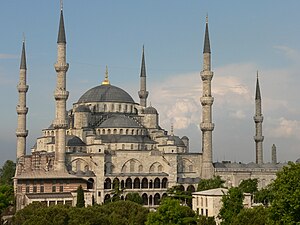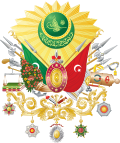 Global Information
Global InformationOttoman architecture information

| Culture of the Ottoman Empire |
|---|
 |
| Visual arts |
|
| Performing arts |
|
| Languages and literature |
|
| Sports |
|
| Other |
|
Ottoman architecture is an architectural style or tradition that developed under the Ottoman Empire over a long period,[1] undergoing some significant changes during its history.[2] It first emerged in northwestern Anatolia in the late 13th century[3] and developed from earlier Seljuk Turkish architecture, with influences from Byzantine and Iranian architecture along with other architectural traditions in the Middle East.[4] Early Ottoman architecture experimented with multiple building types over the course of the 13th to 15th centuries, progressively evolving into the classical Ottoman style of the 16th and 17th centuries. This style was a mixture of native Turkish tradition and influences from the Hagia Sophia, resulting in monumental mosque buildings focused around a high central dome with a varying number of semi-domes.[5][6][7] The most important architect of the classical period is Mimar Sinan, whose major works include the Şehzade Mosque, Süleymaniye Mosque, and Selimiye Mosque.[7][8] The second half of the 16th century also saw the apogee of certain decorative arts, most notably in the use of Iznik tiles.[9]
Beginning in the 18th century, Ottoman architecture was opened to external influences, particularly Baroque architecture in Western Europe. Changes appeared during the style of the Tulip Period, followed by the emergence of the Ottoman Baroque style in the 1740s.[10][11] The Nuruosmaniye Mosque is one of the most important examples of this period.[12][13] The architecture of the 19th century saw more influences imported from Western Europe, brought in by architects such as those from the Balyan family.[14] Empire style and Neoclassical motifs were introduced and a trend towards eclecticism was evident in many types of buildings, such as the Dolmabaçe Palace.[15] The last decades of the Ottoman Empire saw the development of a new architectural style called neo-Ottoman or Ottoman revivalism, also known as the First National Architectural Movement, by architects such as Mimar Kemaleddin and Vedat Tek.[16][14]
Ottoman dynastic patronage was concentrated in the historic capitals of Bursa, Edirne, and Istanbul (Constantinople), as well as in several other important administrative centers such as Amasya and Manisa. It was in these centers that most important developments in Ottoman architecture occurred and that the most monumental Ottoman architecture can be found.[17] Major religious monuments were typically architectural complexes, known as a külliye, that had multiple components providing different services or amenities. In addition to a mosque, these could include a madrasa, a hammam, an imaret, a sebil, a market, a caravanserai, a primary school, or others.[18] Ottoman constructions were still abundant in Anatolia and in the Balkans (Rumelia), but in the more distant Middle Eastern and North African provinces older Islamic architectural styles continued to hold strong influence and were sometimes blended with Ottoman styles.[19][20]
- ^
- Bloom, Jonathan M.; Blair, Sheila S., eds. (2009). "Ottoman". The Grove Encyclopedia of Islamic Art and Architecture. Oxford University Press. p. 82. ISBN 9780195309911.
Throughout their history the Ottomans remained supporters of art and artists. Under their patronage a distinctive architectural style developed that combined the Islamic traditions of Anatolia, Iran and Syria with those of the Classical world and Byzantium. The result was a rationalist monumentality that favored spatial unity and architectonic expression.
- Kuban 2010, p. 7: "Ottoman architecture developed as a unique, enduring architectural style combining the Mediterranean and Near and Middle Eastern traditions in parallel with the political structure of an Ottoman Empire situated at the point of intersection of Asia and Europe and of the Islamic and Christian worlds."
- Gladiss, Almut von (2011). "The Ottoman Empire: Architecture". In Hattstein, Markus; Delius, Peter (eds.). Islam: Art and Architecture. h.f.ullmann. ISBN 9783848003808.
Ottoman art has developed its own particular form of expression in architecture, ceramic tiles and vases, textiles, and last but not least, the art of the book. It set new standards of quality in many fields. The unrestrained enthusiasm of the ruler for ceremonial, the immense financial strength of the empire, an appreciation of planning and precision, as well as an inexhaustible source of ideas which flowed from the master builders, artists, and craftsmen from both Islamic and Christian backgrounds, all helped Ottoman art to flourish over a long period of time.
- Blair & Bloom 1995, p. 134: "The longevity of the Ottomans led to a comparatively clear and consistent stylistic development."
- Bloom, Jonathan M.; Blair, Sheila S., eds. (2009). "Ottoman". The Grove Encyclopedia of Islamic Art and Architecture. Oxford University Press. p. 82. ISBN 9780195309911.
- ^ Kuban 2010, p. 679: "The second important problem in any account of Ottoman architecture concerns the stages in the emergence of radical change. The Green Imaret, Süleymaniye, Nuruosmaniye and Ortaköy mosques are expressions of radically different cultural eras. In the history of Ottoman architecture, architectural design passed through several successive but very clearly distinct stages."
- ^ Freely 2011, p. 35 "The earliest extant Ottoman buildings are in north-western Anatolia, where the Osmanlı Turks first appeared toward the end of the thirteenth century."
- ^
- Harris, Cyril M., ed. (1977). "Seljuk architecture". Illustrated Dictionary of Historic Architecture. Dover Publications. p. 485.
- Ousterhout, Robert (1995). "Ethnic Identity and Cultural Appropriation in Early Ottoman Architecture". Muqarnas. 12: 60. ISBN 9004103147.
- Bloom, Jonathan M.; Blair, Sheila S., eds. (2009). "Ottoman". The Grove Encyclopedia of Islamic Art and Architecture. Oxford University Press. p. 82. ISBN 9780195309911.
Throughout their history the Ottomans remained supporters of art and artists. Under their patronage a distinctive architectural style developed that combined the Islamic traditions of Anatolia, Iran and Syria with those of the Classical world and Byzantium. The result was a rationalist monumentality that favored spatial unity and architectonic expression.
- Ostergren & Le Boss 2011, pp. 215–216: "The grand tradition of Ottoman architecture, established in the 16th century, differed markedly from that of the earlier Moors. It was derived from both the Byzantine Christian tradition, outlined above, and native Middle Eastern forms used by the Islamic Seljuk Turks, who preceded the Ottomans. The Byzantine tradition, particularly as embodied in Hagia Sophia, was perhaps the major source of inspiration."
- Freely 2011, p. 21: "The mosques of the classical period are more elaborate than those of earlier times. They derive from a fusion of a native Turkish tradition with certain elements of the plan of Haghia Sophia, the former cathedral of Constantinople, converted into a mosque in 1453 by Mehmet the Conqueror."
- ^ Freely 2011, p. 21 "The mosques of the classical period are more elaborate than those of earlier times. They derive from a fusion of a native Turkish tradition with certain elements of the plan of Haghia Sophia, the former cathedral of Constantinople, converted into a mosque in 1453 by Mehmet the Conqueror."
- ^ Ostergren & Le Boss 2011, pp. 215–216: "The grand tradition of Ottoman architecture, established in the 16th century, differed markedly from that of the earlier Moors. It was derived from both the Byzantine Christian tradition, outlined above, and native Middle Eastern forms used by the Islamic Seljuk Turks, who preceded the Ottomans. The Byzantine tradition, particularly as embodied in Hagia Sophia, was perhaps the major source of inspiration."
- ^ a b Bloom, Jonathan M.; Blair, Sheila S., eds. (2009). "Ottoman". The Grove Encyclopedia of Islamic Art and Architecture. Oxford University Press. ISBN 9780195309911.
- ^ Gábor Ágoston; Bruce Alan Masters (21 May 2010). Encyclopedia of the Ottoman Empire. Infobase Publishing. p. 50. ISBN 978-1-4381-1025-7.
- ^ Carswell 2006, p. 75.
- ^ Kuban 2010, pp. 505–509, 517–518.
- ^ Ünver 2019, pp. 18–22, 55 and after.
- ^ Freely 2011, p. 355.
- ^ Kuban 2010, p. 526.
- ^ a b Freely 2011, p. 393.
- ^ Kuban 2010, pp. 605–606.
- ^ Bloom, Jonathan M.; Blair; Sheila S. (2009). "Kemalettin". Grove Encyclopedia of Islamic Art & Architecture: Three-Volume Set. Oxford University Press. p. 379. ISBN 978-0-19-530991-1.
- ^ Kuban 2010, p. 679.
- ^ Kuban 2010.
- ^ Kuban 2010, pp. 571–596.
- ^ Blair & Bloom 1995, p. 251.